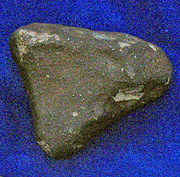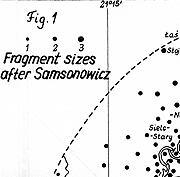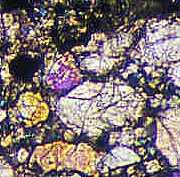Official Name:
Pultusk is the official name of this meteorite. It is also known by many other names, including Warsaw, Nossi-Bé, Spezia, Ostrolenka and Goskowo.
Location:
Between the villages of Pultusk and Ostrolenka, a few kilometres northeast of the city of Warsaw, Poland.
Fall or Find:
Fall
Date:
30 January 1868, about 7:00 p.m., local time.
Mass Recovered:
Approximately 200 kilograms of meteoritic matter were collected. The total mass on the ground was estimated at 2 metric tons.
Number of Fragments:
Between 100 000 and 300 000 fragments reached the Earth's surface that night, varying in weight from 1 gram to 9 kilograms. Most of the stones were quite small, so they were called "Pultusk Peas."
Strewn field:
Pultusk's strewn field measures 16 kilometres by 8 kilometres. The fireball stopped glowing at an altitude of 40 kilometres. Fragmentation rarely occurs this high up-it caused small fragments to be scattered as far away as Madagascar, Italy, and Russia. Analyses have shown that they all came from the same celestial body.

Enlargement
Small fragment of the Pultusk meteorite with original label from Vienna's Naturhistorisches Museum, Austria. |
|

Enlargement
Illustration of the Pultusk meteorite's strewn field. |
|
Circumstances:
Thousands of observers in Poland saw a large fireball cross the sky. A series of explosions followed, and then thousands of small stones rained down on the land and houses in the area. According to some witnesses, the meteoroid was visible very shortly after it entered the atmosphere, which means at an altitude of about 300 kilometres! This makes it the highest fireball ever observed with the naked eye.
The next morning, residents began gathering up meteorites from the snow. The stones all had a black fusion crust, which contrasted strongly with their pale grey interiors.
History:
In the nineteenth century, scientists calculated the orbit of the Pultusk meteoroid to find out where it came from. They concluded that the meteoroid came from outside the solar system. It took several decades to correct this hypothesis: the meteoroid actually came from the asteroid belt.
Type:
Stony meteorite
Class:
Ordinary chondrite
Group:
H5
Composition:
Pultusk has a high metal content-over 27% of its volume is iron. Olivine and bronzite are its two principal minerals. They are found mainly in the meteorite's chondrules. We know that this chondrite was slightly altered by heat, because the contours of its chondrules are difficult to make out.

Enlargement
Thin section of the Pultusk meteorite seen through polarized light. A chondrule with an indistinct contour is visible at the centre of the photograph. |
|
Scientific contribution:
Not all of the meteoritic debris from the Pultusk shower was collected. This is due to the small size of the fragments and the age of the fall-in the nineteenth century, meteorite hunters were rare! Scientists have proposed different equations to evaluate the number of fragments that reached the ground. For over one hundred years, estimations have varied considerably-from 3 000 stones to an infinite number of them! Even today, no final figure has been agreed upon, but we generally speak of 100 000 or more fragments.
Comments:
To this day, Pultusk is the meteorite shower that has produced the largest number of fragments.
Part of the Planétarium's collection:
Yes